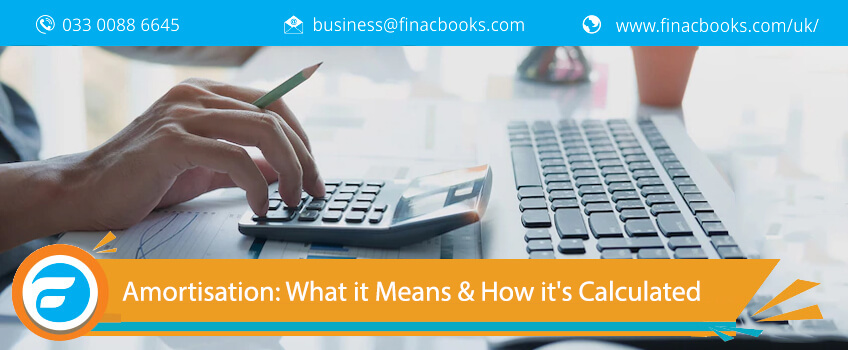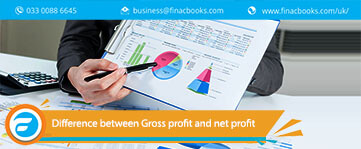Amortisation
Amortisation refers to the process of a routine decrease in the value of an intangible asset in order to show how its worth has reduced overtime or the process of paying off a debt over time by making regular payments. It is, therefore, similar to depreciation, the term Amortisation is more commonly used to denote a reduction in the value of intangible assets, such as intellectual property, patents, trademarks, copyrights, etc. Amortisation, in other words, essentially a means of associating the cost of an asset to the revenue it generates over the time it is in service. For example, you may lease a building for 10 years, and after 10 years, the amount you have paid as lease becomes zero. Often the term amortisation instead of depreciation is used to denote depreciation of such assets. When you pay your loans in instalments over a period of time, it will also fall under amortisation.

Calculating amortisation – example
Assume your company has taken out a £5 million loan (Loan's Principal/Loan amount) to pay the costs connected with entering a new market. If you repay £250,000 of that loan each year, the debt will be amortised annually. However, you will be required to pay interest payments on this loan as well. Assume you have negotiated at a 10% annual interest rate with your lender – £25,000. As a result, you will need to pay £275,000 per year in order to completely amortise the debt.
Consider another scenario: Suppose you were granted ten years to repay a bank £1.5 million in business loans on a monthly basis. To calculate your monthly amortisation obligations, divide £1.5 million by ten, which equals £150,000 per year.
Reasons for value Depreciation
Economic factors, depletion, time and physical deterioration are the primary causes of depreciation. Each is briefly explained as follows:
For example, if a truck cost £6000 and it is assumed that it will be in service for three years, it means that one-third of its value is consumed at the end of the first year. Depreciation as such would be $2000, i.e. one-third of the cost of the truck. Profit would be reduced by £2000, and the value of the truck in the balance sheet at the end of the first year would diminish from £6000 to £4000.
- Wear and tear Taking the example of the truck above, it is natural to expect that with the passage of time and usage, its parts, tires, engine, paint, etc., will eventually tear off. How long it remains in service depends upon its quality, maintenance and usage, among other things.
- Erosion, Rust, Decay, etc. Land may suffer erosion by actions of nature such as rain, wind, heat, etc. Similarly, the metals used in a motor vehicle will rust away.
- Depletion Assets such as oil wells, mines, etc., are of wasting character, as raw material is extracted from them to make something else or they are sold in their raw state to other businesses.
In the reducing balance method of depreciation, the depreciation expenses diminish with each accounting period. In other words, it charges depreciation at a higher rate in the earlier years of an asset. The amount of depreciation reduces as the life of the asset progresses.
Amortisation and Loans
Amortisation in the context of loans refers to the repayment of loans over a period of time as per the pre-agreed schedule.
Appreciation
Appreciation is just the opposite of depreciation. It is an increase in the value of an asset. There could be a variety of reasons for augmentation in the value of an asset, like heightened demand for the asset, mismatch between demand and supply, inflation, etc. An important thing to note is that both tangible and intangible assets could see their value rise. For example, it is common for trademarks to increase in value if the brand has gained acceptance in the marketplace.
Appreciation vs Depreciation
Appreciation is the increase in the value of an asset. Depreciation is a decrease in the value of an asset. Depreciation is predominant, but that does not mean that appreciation does not occur. Certain assets are purchased for the sole purpose of selling them at a higher price in future. Prime examples are equity and property whose value is generally appreciated with the passage of time. On the other hand, certain assets like machinery, technology, etc., will lose over its value over time. As a general rule, assets with finite useful life are more likely to undergo depreciation.
How to account for appreciation?
Assets are recorded at their historical cost. What it means is that financial statements cannot be changed to record their enhanced value. The difference between an asset's book price and new market value is therefore recorded in an equity account called ‘revaluation surplus. Also, since appreciation is not considered to be a normal gain, any increase in an asset’s value is not recorded in the income statement.
Currency Appreciation We keep hearing about currency appreciation. It implies that apart from assets, currencies too appreciate. This could be either owing to strong economic performance or more demand for that currency in the market. Short term currency appreciation could be owing to trade flows or market speculation whereas low inflation is generally responsible for long term currency appreciation.
Economic factors Are there a possibility that the asset may be taken out of service even if it is in working condition. The answer is: Yes. Obsolescence and inadequacy are two major factors that contribute to this.
Obsolescence Assets frequently decrease in value as they are replaced by new and improved models. For example, there have been great technological advances in the field of computers. Both hardware and software undergo rapid updation making a computer’s hardware as well as software obsolete, and much of it is taken out of service within two to three years. This, however, in a way implies that they are not in working condition and can be easily used by someone who cannot afford to buy a new piece.
Inadequacy This happens when the asset is put out of service because of the growth and changes in the size of the business. For example, a small boat operated by a small business at a coastal resort will no longer serve its purpose once the resort becomes popular and the numbers of tourists increase significantly. Under such circumstances, the resort owner may opt for a larger boat to ferry passengers. It does not mean that the smaller boat has become obsolete; it is just that it has become inadequate for the present business.
Time factor This is self-explanatory as erosion, decay, rust, wear and tear, along with obsolescence and inadequacy, all happen with the passage of time. However, there are certain fixed assets that have a life fixed in legal terms. For example, you may lease a building for 10 years, and after 10 years, the amount you have paid as lease becomes zero. Often the term Amortisation instead of depreciation is used to denote depreciation of such assets.
Impairment Loss
An impairment loss is a loss that represents a permanent decrease in the value of an asset. An impairment loss is a recognized reduction in the carrying amount of an asset that is triggered by a reduction in the remedial amount of a fixed asset or goodwill below its book value. Accounts will register the value of assets: fixed assets, current assets, etc., which are determined by the market. However, as expected, the value of assets diminishes over time. The loss in the value of an asset may be attributed to factors like strength, quality, value, etc. This is called impairment. On the other hand, when the value of the asset increases, it is called appreciation.
Fixed assets have a definite value, and the value of fixed assets such as machinery, equipment are generally prone to impairment. The southwards moving value could be attributed to factors like poor maintenance, wear and tear, rust, corrosion, etc. A fixed asset will see its value gradually decrease over time, and this depreciation is spread over the asset’s useful life.
How to determine Impairment?
Impairment, as mentioned above, refers to the phenomenon of a sharp decline in the value of a fixed asset compared to its market or book value. This will reflect in the balance sheet, which needs to be altered to reflect the change in the new value of the asset in comparison to its original recorded value.
The original value of the asset with its recoverable amount determines the impairment value of an asset. It is be noted that the recoverable amount is the highest value that can be obtained by selling the asset.
It is important that an accountant keeps a close eye on fixed assets that are susceptive to impairment so that the write-offs are properly handled and recorded in the business accounts.
What's the difference between Amortisation and Depreciation?
The cost of business assets is expensed each year over the asset’s life. This expense associated with business assets are tax-deductible, i.e. businesses can claim a tax deduction on the reduction in the quality, quantity or value of an asset. It is known that assets cannot last forever and ever. A certain number of years are estimated, which points out to the asset's useful life. There are basically three methods that are used by organizations to spread the cost of an asset. We will discuss about these three methods in the following paragraphs. Also, it is important to remember that the three types of methods are used depending upon the type of asset in question.
Depreciation
Depreciation refers to the gradual decrease in the quality, quantity or value of a fixed asset. Please note that depreciation is associated with ‘fixed assets’. Also, it is worth mentioning that fixed assets are assets that are tangible, i.e. they can be physically touched, known as tangible assets. A Few common examples of fixed assets that are usually depreciated are mentioned as follows:
- Machinery
- Land
- Vehicle
- Furniture, etc
It is fully possible for physical assets to still have some value at the end of their useful life. This value is called resale or salvage value or scrap value, and to calculate depreciation, you have to subtract the scrap value from the asset’s original cost. For example, a building serving as an office for an organization can be used for many years until it reaches the end of its useful life and is sold. The cost associated with the building is spread over all the years it has been in service, and the depreciation suffered by it will be a tax deduction for the company.
Also, depreciation of some fixed assets such as a vehicle is done on an accelerated basis. It means the rate of depreciation is taken to be much higher in the initial years. This is known as the reducing balance method of depreciation. The depreciation expense under the reducing balance method gradually reduces over the assets useful life. In the case of the fixed instalment method, depreciation remains of the same amount every year, whereas in the case of the reducing balance method, the amount of annual depreciation progressively declines.
The Reducing balance method of depreciation is most appropriate in cases of assets that offer higher productivity during their initial years. Computers, for example, have better functionality during their initial years of being put into service. Also, rapidly advancing technology makes computer obsolete rather fast. Using the reducing balance method to calculate depreciation of computers ensures that higher depreciation is charged in the initial years of its operation.
Under this method, the real cost of using an asset is the sum total of depreciation and the repair cost associated with the equipment or the machinery. This is a more reliable method as in the initial years, the high rate of depreciation and low maintenance cost balances each other out. With the progress of time, as the asset gets older, the depreciation rate lowers, but the maintenance cost goes up, and as such, the profit and loss of each year more or less remains constant. A major shortcoming of this method is that it takes very long to determine the residual value or scrap value of an asset. The time period can be shortened, but then the depreciation rate would have to be much higher, which can put an excess burden during the initial years. Income tax authorities generally employ this method to grant depreciation allowance.
Amortisation
Amortisation is the same as depreciation, with the only difference being it deals with intangible assets, unlike fixed assets as is the case with depreciation. A Few examples of intangible assets where Amortisation is applied are as follows:
- Trademarks
- Loans
- Patents
- Copyrights
- Franchise agreements, etc
Unlike depreciation which is calculated using reducing balance depreciation, Amortisation is calculated using the straight-line method of depreciation, meaning the amount of annual depreciation remains the same. Also, unlike depreciation, assets in the case of Amortisation do not possess any salvage value.
Depletion
Depletion refers to the depreciation of natural resources over time. Assets such as oil wells, mines, etc., are of wasting character, as raw material is extracted from them to make something else or they are sold in their raw state to other businesses.
For example, an oil well has a useful life only as long as oil is there. Therefore, the oil well's setup costs are spread out over the number of years the oil-well may be in service. Please note that depreciation, depletion and Amortisation are non-cash expenses as no cash is spent on them. It is just their value that diminishes with the passage of time.
How do Finacbooks help?
FinacBooks is a leading platform where you can search for qualified accountants offering a range of services like Bookkeeping, VAT Registration & Return filing, Payroll registrations and RTI returns, Pensions and auto-enrolment, Tax investigation service, Business plans, management accounts and more.
Any Questions? Request a callback from our Tax Experts.


































